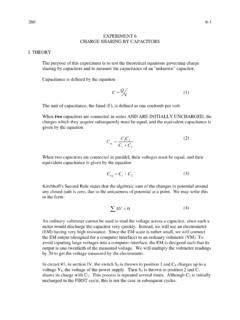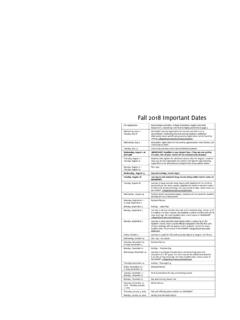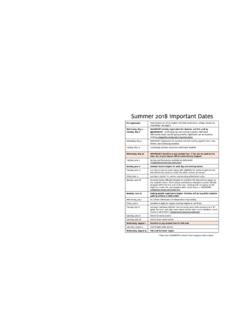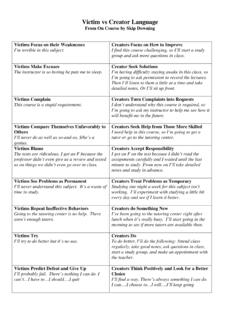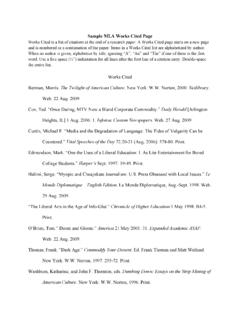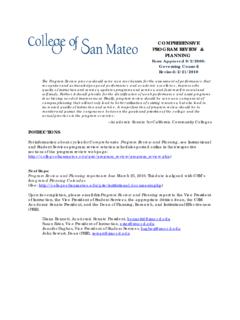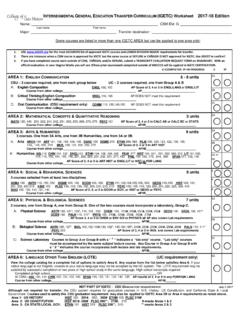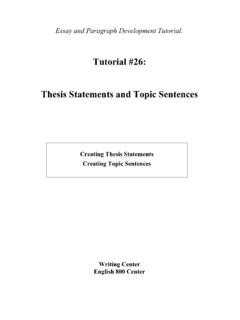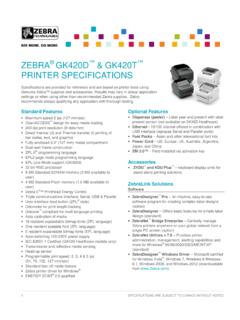Transcription of Tutorial 19: Adjective Clauses - College of San Mateo
1 Sentence Development Tutorial : Tutorial 19: Adjective Clauses Writing Center English 800 Center All notes and exercises should be done on separate sheets of paper, which you will bring to your conference with an instructor in the center. As you work through the Tutorial , make sure to see an instructional aide at the front desk in the Writing Center or English 800 Center if you have any questions or difficulties. 2. Adjective Clauses Consider the following sentences: A. I cannot find the man from the repair shop. He helped me fix my car yesterday. B. I cannot find the man from the repair shop that helped me fix my car yesterday. In your own words, explain which writing is better, A or B, and why.
2 As you may have noticed, the sentences in A are short, choppy, and disconnected. On the other hand, the sentence in B, connects the ideas in those two sentences smoothly. Instead of using two sentences to convey the information about the man from the repair shop, the writer has combined the sentences using an Adjective clause: that helped me fix my car yesterday. An Adjective clause describes a noun in the same sentence. In this case, the Adjective clause that helped me fix my car yesterday describes the man from the repair shop with extra, descriptive information without the writer having to create a new sentence. Understanding how an Adjective clause works is easiest if you recognize the sentence that contains the Adjective clause as a transformed combination of two separate sentences.
3 In both A and B, a pronoun represents the noun, man. In A, the pronoun, he, is the man from the repair shop. In sentence, B, the pronoun, that, is also the man from the repair shop. The pronoun that allows the writer to combine the first two sentences into one. Pronouns that begin adjectives Clauses are called relative pronouns. Consider the next two sentences. A. The photographer asked Alejandro and Jaime to the party. She works for Time. B. The photographer who works for Time asked Alejandro and Jaime to the party. In A, the pronoun, she, is the photographer. In the combined sentence, B, the relative pronoun, who, is also the photographer. The relative pronoun, who, begins the Adjective clause, who works for Time, and allows the writer to combine the two sentences into one.
4 Principle I: To combine two separate sentences into a single sentence with an Adjective clause, you must change the pronoun into a relative pronoun like that, who, or which. 3. Creating Adjective Clauses This is a list of the relative pronouns that begin Adjective Clauses , the kinds of nouns that each relative pronoun can refer to, and the pronoun that each relative pronoun can replace in a combined sentence. RELATIVE REFERS TO REPLACES USAGE EXAMPLE. PRONOUN. Who people or she, he, Subject of clause Fido, who loves to run fast, is a very large black animals they dog. Fido is a very large black dog. He loves to run fast. (subject). Whom people or her, him, Object of verb or Fido, whom I personally trained, works as a animals them preposition within guide dog.
5 Clause Fido works as a guide dog. I personally trained him. (object). Remember the M > Whom = him. Which things it, they, Can be subject or George bought a used car which/that gave him them object endless problems. George bought a used car. It gave him endless problems. (Subject). George bought a car which/that he thought he would like. George bought a car. He thought he would like it. (object). That people or she, he, Can be subject or He has found a mechanic that/who does excellent things they, it; object work. her, him, He has found a mechanic. He does excellent them work. Whose people or her, his, Possessive The mechanic works in a garage whose sign is things their; its broken.
6 The mechanic works in a garage. Its sign is broken. Where place there The mechanic works at the garage where all the here locals hang out. The mechanic works at the garage. All the locals hang out there. Preposition + person her, him, Be careful not to repeat The salesperson from whom George bought his Whom them the preposition. car was a jerk. The salesperson was a jerk. George bought his car from him. Preposition + thing it, they, Be careful not to repeat The credit card which he paid with was declined. Which them the preposition. The credit card was declined. He paid with it. 4. Exercise 1. Instructions: The noun and its pronoun in each group of sentences are in boldface.
7 Using Principle I and the chart Creating Adjective Clauses , combine the sentences with an Adjective clause, by replacing the pronoun with the correct relative pronoun who, that, or which. The first one has been done for you. 1. Lydia bought a used car. It gave her endless problems. Lydia bought a used car that (or w hich) gave her endless problems. 2. Lydia took her car to a mechanic. He told her it would cost $560 to fix it. Lydia took her car to a mechanic _____ told her it would cost $560 to fix it. 3. Lydia bought a new car. It runs like a dream. Lydia bought a new car _____ runs like a dream. Placement of Adjective Clauses and Relative Pronouns Adjective Clauses must be placed right after the nouns they modify.
8 For example, to make the second sentence below into an Adjective clause, we have to ask the question: what does it refer to the chair or the TV? The chair is next to the TV. It is older than my little sister. If it refers to the chair, then put the Adjective clause right after the word chair: The chair, which is older than my little sister, is next to the TV. If it refers to the TV, then put the Adjective clause right after the word TV: The chair is next to the TV, which is older than my sister. Another point to remember about Adjective Clauses is that sometimes the pronoun you are replacing may not come at the beginning of the sentence. For example: Laura bought some tomato paste.
9 She planned to use it to make spaghetti sauce. Laura bought a can of tomato paste, which she planned to use to make spaghetti sauce. 5. Here, the pronoun being replaced, it, is in the middle of the sentence. It is important to place the Adjective clause that begins with the relative pronoun right after the noun that it modifies, in this case, which. You would not simply want to replace it with which. For example, consider this incorrect sentence: Laura bought a can of tomato paste she planned to use which to make spaghetti sauce. Principle II: It is important to place the Adjective clause right after the noun that it modifies. Always put the relative pronoun that replaces the pronoun at the beginning of the Adjective clause.
10 Exercise 2. Instructions: Using Principles I and II and the chart Creating Adjective Clauses , combine the sentences with an Adjective clause, by replacing the pronoun with the correct relative pronoun. The first one has been done for you. 1. Mickey bought a stereo. He believed it was well made. Mickey bought a stereo that he believed was well made. 2. The boy wears a ring in his nose. He is our number one suspect. 3. The girl did well on her last English paper. Tom knows her from high school. 4. The fan broke a week after the warranty expired. I bought it at Target. 6. Exercise 3. Instructions: It is important to remember that who, which, and that, are not the only relative pronouns.
